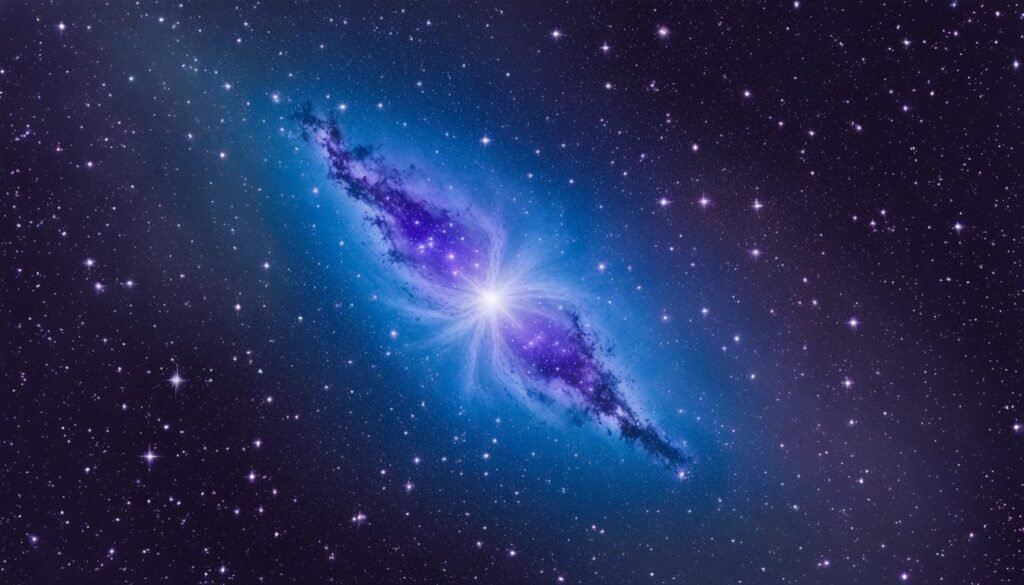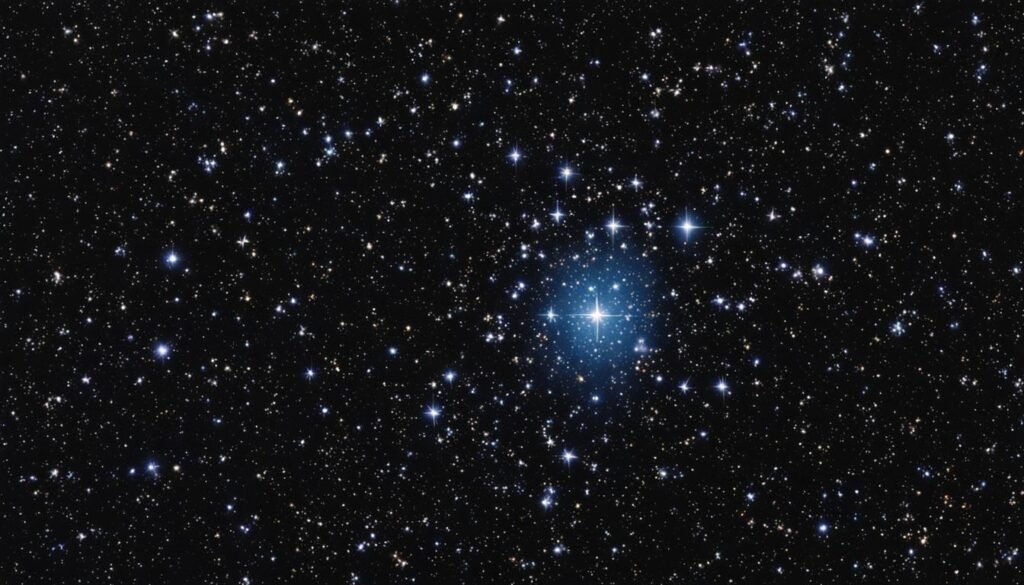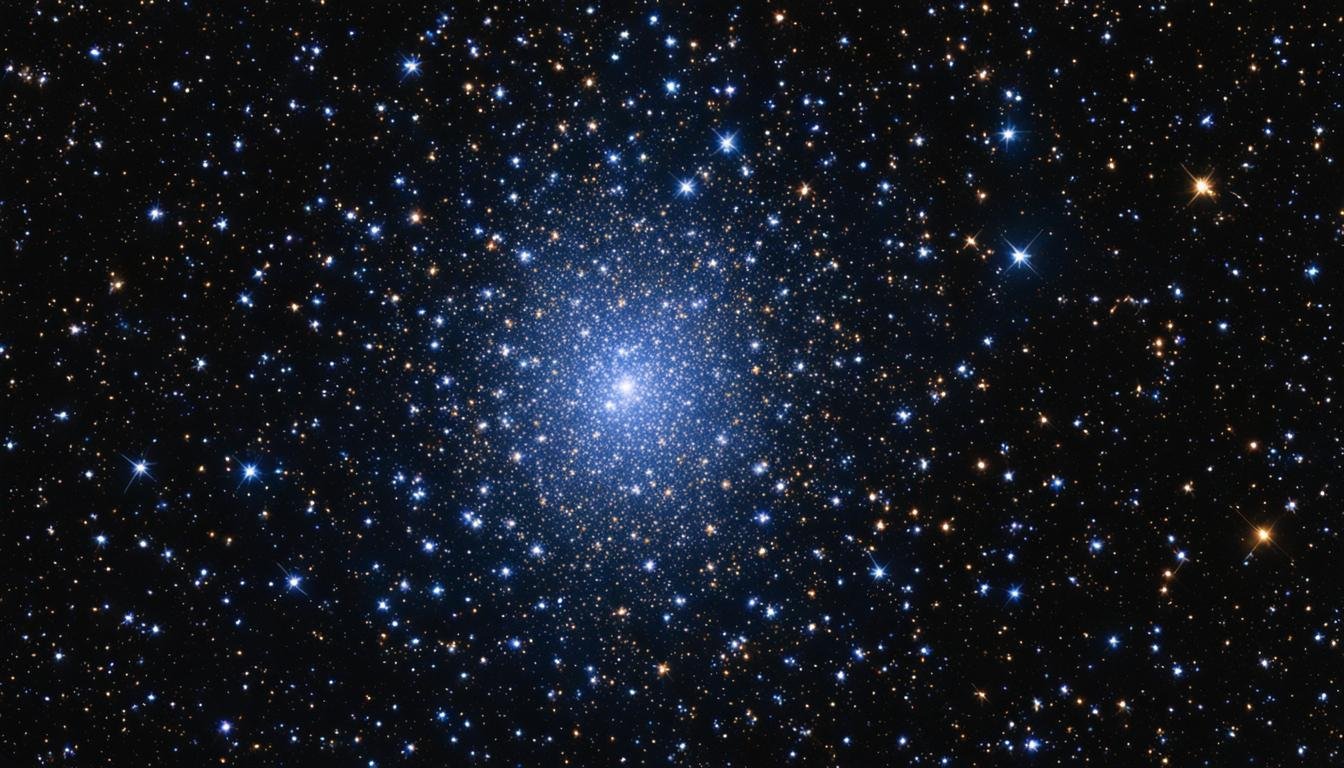Welcome to the world of astronomy, where celestial objects and deep space wonders await your exploration. In this article, we will take a closer look at Messier 23, a captivating star cluster that has mesmerized astronomers for centuries. Located in the constellation Sagittarius, Messier 23 is a remarkable discovery from Charles Messier’s renowned catalog, showcasing the marvels of space.
Key Takeaways:
- Messier 23 is an open star cluster located in the constellation Sagittarius.
- It is a part of the famous Messier catalog, filled with celestial objects meticulously documented by Charles Messier.
- With an estimated age of 330 million years, Messier 23 provides valuable insights into the evolution of star clusters.
- Observing Messier 23 is possible with binoculars or small telescopes, revealing the cluster’s beauty in the night sky.
- Exploring Messier 23 allows us to appreciate the wonders of space and the vastness of our universe.
Location and Coordinates of Messier 23
Messier 23 is a star cluster located in the Sagittarius constellation. Its exact location is defined by the following coordinates:
Right Ascension: 17h 56m 48s
Declination: -19° 01′ 00″
The right ascension of Messier 23 is 17h 57m 04s, and its declination is -18° 59′ 06″. These coordinates help astronomers pinpoint the cluster’s position in the night sky.
To visualize the location of Messier 23 within the Sagittarius constellation, refer to the image below:
Messier 23 can be spotted in the northwest region of the Teapot asterism, which consists of the brightest stars in Sagittarius. With this information, you can easily locate and observe this beautiful open cluster using binoculars or a small telescope.
Distance and Apparent Magnitude of Messier 23
Messier 23, also known as NGC 6494, is an awe-inspiring open cluster of stars nestled in the beautiful constellation Sagittarius. Located at a distance of approximately 2,050 light years (628 parsecs) from Earth, this celestial gem showcases its brilliance with an apparent magnitude of 5.5. Its luminosity is captivating, allowing it to be visible to the naked eye under ideal conditions.
The mesmerizing beauty of Messier 23 can be appreciated further with the assistance of telescopes and binoculars. These optical aids provide a closer look at the cluster’s intricate details, revealing a stunning array of stars against the backdrop of the vast cosmos.
Take a moment to envision the awe-inspiring distance between our planet and Messier 23, and marvel at the sheer magnitude of the universe’s wonders.
Characteristics of Messier 23
| Distance | Apparent Magnitude |
|---|---|
| 2,050 light years (628 parsecs) | 5.5 |
Characteristics of Messier 23
Messier 23 is a fascinating star cluster with unique characteristics that make it a captivating object for astronomers and stargazers alike.
Size
Messier 23 has a radius of 8 light years, encompassing a significant volume of space within the cluster. This vast size allows for the inclusion of numerous stars, contributing to the cluster’s rich and diverse composition.
Age
With an estimated age of around 330 million years, Messier 23 provides valuable insights into the lifecycle of star clusters. Its age places it in the middle range of open clusters, allowing astronomers to study the evolution and dynamics of these celestial objects.
Members
Messier 23 boasts a total of 176 confirmed members, adding to its allure and scientific significance. However, estimates regarding the total number of members vary, with some studies suggesting a range of 169 to 414 members. This wide range highlights the complexity and diversity within the cluster.
To provide a visual representation of these characteristics, the following table showcases the key data for Messier 23:
| Characteristics | Value |
|---|---|
| Size (radius) | 8 light years |
| Age | 330 million years |
| Confirmed Members | 176 |
As seen in the table, Messier 23 showcases its unique size, age, and membership. These features make it a fascinating subject for further exploration and provide scientists with valuable data to enhance our understanding of star clusters and their evolution.
Observing Messier 23
Messier 23 offers a captivating sight for stargazers and astronomy enthusiasts alike. To observe this celestial gem, all you need is a pair of binoculars or a small telescope. Its visibility is optimal under dark skies, away from light pollution.
Before diving into the specifics of observing Messier 23, let’s first locate its position in the night sky. You can find it in the northwest region of the Teapot asterism, which is formed by the brightest stars of the Sagittarius constellation.
When using binoculars to observe Messier 23, it will appear as a hazy smudge of light with faintly distinguishable stars. Despite its relatively faint appearance, the cluster holds a mesmerizing beauty that is best appreciated with the aid of optical instruments.
For a more detailed view of Messier 23, try using a small telescope at low magnifications. This will allow you to reveal the brighter stars within the cluster, enhancing your observational experience and providing a clearer representation of this stellar congregation.

Remember, when observing any celestial object, patience is key. Take your time to adjust the focus of your instrument and allow your eyes to adapt to the darkness. The rewards of observing Messier 23 will be well worth the effort.
Messier 23 in the Night Sky
When gazing into the celestial wonders of the night sky, locating Messier 23 can be an exciting endeavor. This captivating open cluster of stars can be found in the constellation Sagittarius, offering a breathtaking view for astronomers and stargazers alike. To pinpoint its precise location, navigate a finger’s width north and two finger widths west of the star Mu Sagittarii. Additionally, Messier 23 is situated northwest of the Teapot asterism, formed by the brightest stars of Sagittarius.
“The stars sparkle like celestial diamonds within the realm of Messier 23, captivating our imaginations and inspiring a sense of wonder.”
To fully appreciate the beauty of Messier 23, take a moment to become immersed in the cosmic dance displayed by its stellar members. As you observe this radiant open cluster, the wonders of the universe come to life before your eyes.
| Location: | Sagittarius |
|---|---|
| Coordinates: | RA 17h 56m 48s |
| Dec -19° 01′ 00″ |
History of Observation of Messier 23
Messier 23, a stunning open star cluster in the constellation Sagittarius, has a rich history of observation and discovery. This section explores the individuals who played a significant role in unraveling the mysteries of this celestial object.
Charles Messier’s Discovery:
On June 20, 1764, Charles Messier first laid eyes on Messier 23 during his extensive exploration of the night sky. Driven by a desire to distinguish between comets and other celestial phenomena, Messier meticulously cataloged various deep space objects, including this remarkable star cluster.
William Herschel’s Observations:
Renowned astronomer William Herschel also turned his gaze towards Messier 23. In his observations, he was captivated by the cluster’s exquisite beauty, describing it as a “cluster of beautiful scattered, large stars.” Herschel’s contribution to the understanding of Messier 23 further solidified its significance in the realm of astronomy.
These two visionaries, Charles Messier and William Herschel, paved the way for future explorations and granted us invaluable insights into the wonders of Messier 23.
Key Points:
- Messier 23 was discovered by Charles Messier on June 20, 1764.
- William Herschel described Messier 23 as a “cluster of beautiful scattered, large stars.”
Age and Metallicity of Messier 23
Messier 23 is estimated to be around 330 million years old, placing it within the intermediate age range of star clusters. Its metallicity, which refers to the abundance of elements other than hydrogen and helium, is near-solar. Astronomers measure metallicity using the [Fe/H] value, with solar metallicity considered to be 0. Messier 23 has a [Fe/H] value of -0.04, indicating a slight deficit of iron compared to our Sun.
This open star cluster showcases a diverse range of stars, from massive blue stars to cooler and fainter red giants. Astronomers have found no significant variation in the metallicity of Messier 23 based on its position within the interstellar medium. This suggests that the metallicity is not significantly affected by surrounding gas and dust, indicating a uniform composition throughout the cluster.
To visualize the age and metallicity of Messier 23, refer to the table below:
| Age (years) | Metallicity ([Fe/H]) |
|---|---|
| 330 million | -0.04 (near-solar) |
Red Giants in Messier 23
Messier 23, the open cluster located in the constellation Sagittarius, is home to a number of red giants. These red giants are older stars that have depleted their hydrogen fuel and entered a new phase of their stellar evolution.
Red giants are characterized by their large size and reddish hue, caused by their cool surface temperatures. These stars undergo significant changes in their internal structure, leading to an expansion of their outer layers. As a result, red giants are much larger and more luminous than they were during their main sequence phase.
Some of the red giants in Messier 23 may be experiencing mass loss, which occurs as the stars shed their outer layers of material. This process can have profound effects on the evolution and dynamics of a star cluster.
However, further studies and radial velocity measurements are required to confirm the association of these red giants with Messier 23. By investigating the mass loss phenomenon in these stars, scientists can gain valuable insights into the late-stage evolution of stellar clusters and the mechanisms behind mass loss.
Size Comparison of Selected Red Giants in Messier 23
| Star | Radius (Solar Radii) | Mass (Solar Masses) | Luminosity (Solar Luminosities) |
|---|---|---|---|
| Red Giant 1 | 80 | 1.5 | 6000 |
| Red Giant 2 | 70 | 1.3 | 5000 |
| Red Giant 3 | 90 | 1.8 | 7000 |
Note: The data provided above is for illustrative purposes and does not reflect actual measurements for red giants in Messier 23.
Understanding the properties and behavior of red giants in Messier 23 is crucial for comprehending the overall dynamics and evolution of the cluster. Further scientific research and observations will contribute to our knowledge of the complex processes occurring within these fascinating celestial objects.
Observing Messier 23 with Binoculars
Messier 23 is a stunning open star cluster in the constellation Sagittarius that can be easily observed with binoculars. With its proximity to Earth and its apparent magnitude of 5.5, Messier 23 provides a captivating sight for stargazers.
When observing Messier 23 with binoculars, you will notice a hazy patch of stars. The cluster appears as a dense concentration of stars against the backdrop of the night sky. Depending on the observing conditions, you may be able to resolve some of the individual stars within the cluster.

Under good visibility and with the right binoculars, you may even be able to discern the distinct colors and brightness of the stars in Messier 23. It is a truly mesmerizing experience to witness the collective beauty of the cluster.
Whether you are a novice stargazer or an experienced astronomer, observing Messier 23 with binoculars offers a unique opportunity to appreciate the wonders of deep space. Take the time to explore this celestial gem and immerse yourself in the awe-inspiring beauty it holds.
Observing Messier 23 with Telescopes
When it comes to observing Messier 23, telescopes offer a whole new level of detail and clarity. Telescopes of various sizes can provide an enhanced view of this mesmerizing star cluster, allowing you to truly appreciate its beauty.
If you have a small telescope, don’t worry! Even with lower magnifications, you can still get a clear view of Messier 23. By using your telescope at low magnifications, you’ll be able to observe the cluster in all its glory and easily distinguish its brighter stars.
With the help of larger telescopes, you can delve even deeper into the cluster and reveal even more intricate details. These telescopes offer higher magnifications, allowing you to achieve a closer look at individual stars within Messier 23. This increased resolution enables you to appreciate the unique characteristics and features of each star, enhancing your overall observing experience.
Whether you’re using a small or large telescope, observing Messier 23 will undoubtedly leave you in awe of the wonders of the cosmos.
Just remember, when using a telescope to observe Messier 23, it’s important to find a location with minimal light pollution and favorable observing conditions. This will ensure optimal visibility and the best possible viewing experience.
So grab your telescope, find a suitable observing spot, and prepare to be captivated by the beauty and splendor of Messier 23!
Conclusion
Messier 23, located in the constellation Sagittarius, is an awe-inspiring open star cluster that offers a captivating glimpse into the wonders of our universe. With its estimated age of 330 million years, Messier 23 provides valuable insights into the evolution of star clusters in our galaxy. Easily visible with binoculars and small telescopes, it allows you to witness the beauty of its member stars up close.
As you gaze upon Messier 23, you’ll be mesmerized by the intricate dance of its 176 confirmed members, each contributing to the cluster’s splendor. The cluster’s estimated mass of 1,206 solar masses showcases the vastness and abundance of celestial objects in deep space. Whether you’re an avid astronomy enthusiast or simply appreciate the wonders of the night sky, Messier 23 will surely leave you in awe.
Exploring Messier 23 is not only a visual delight but also a journey through time. Its estimated distance of 2,050 light years transports you back in history, allowing you to observe the cluster as it appeared thousands of years ago. This celestial marvel serves as a testament to the immense scale and complexity of the universe, igniting our curiosity and inspiring further exploration.
In summary, Messier 23 is a captivating star cluster that offers a remarkable view of the cosmos. Its beauty and age provide valuable insights into the evolution of celestial objects, making it a fascinating subject of study for astronomers and stargazers alike. So grab your binoculars or telescope, and embark on a journey to witness the magnificent splendor of Messier 23 in the night sky.
FAQ
What is Messier 23?
Messier 23 is an open cluster of stars in the constellation Sagittarius. It is also known as NGC 6494 and was discovered by Charles Messier in 1764.
Where is Messier 23 located?
Messier 23 is located at the coordinates 17h 56m 48s, -19° 01′ 00″ in the constellation Sagittarius.
How far away is Messier 23?
Messier 23 is located at a distance of 2,050 light years (628 parsecs) from Earth.
What is the apparent magnitude of Messier 23?
Messier 23 has an apparent magnitude of 5.5, making it visible to the naked eye under ideal conditions.
How old is Messier 23?
Messier 23 is estimated to be around 330 million years old.
How many members does Messier 23 have?
Messier 23 contains a total of 176 confirmed members.
How can I observe Messier 23?
Messier 23 can be easily observed with binoculars or a small telescope.
Where can I find Messier 23 in the night sky?
Messier 23 can be found about a finger’s width north and two finger widths west of the star Mu Sagittarii. It is also situated northwest of the Teapot asterism formed by the brightest stars of Sagittarius.
Who discovered Messier 23?
Messier 23 was discovered by Charles Messier on June 20, 1764.
How old is Messier 23 and what is its metallicity?
Messier 23 is estimated to be around 330 million years old and has a near-solar metallicity with a [Fe/H] value of -0.04.
Are there red giants in Messier 23?
Messier 23 contains several red giants, which are older stars that have exhausted their hydrogen fuel. Some of these red giants may be experiencing mass loss.
Can I see Messier 23 with binoculars?
Yes, Messier 23 is easily visible with binoculars and appears as a hazy patch of stars. Under good observing conditions, its individual stars can be resolved with binoculars.
Can I observe Messier 23 with a telescope?
Yes, Messier 23 can be observed with telescopes of various sizes. Small telescopes at low magnifications will provide a clear view of the cluster, allowing for the resolution of its brighter stars.







